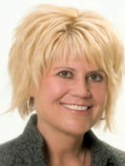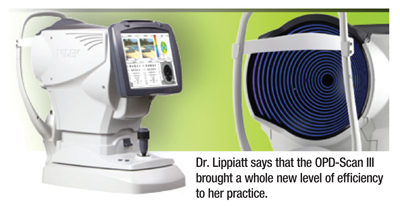

Even knowing that there will be an adjustment and learning curve with bringing in new technology, Lorie Lippiatt, OD, says that it’s worth it. She has been in practice for 26 years in Salem, Ohio, and has spent much of that time working with companies consulting and beta testing new technologies. She’s worked on electronic medical records for several companies, integrating medical equipment and improving office flow. In fact, she says, her office has such a reputation for a well-planned office flow that other doctors have come to observe it.
Dr. Lippiatt first added two TRS-5100 digital refraction systems from Marco about eight years ago and then brought one of those units into each of her four exam lanes. “Once we understood the efficiencies it brought into the workflow, it became nearly impossible to use a manual system from the standpoint of time and accuracy,” she says. Integrating the TRS-5100 into the Eyefinity ExamWriter® electronic health records software doubled the practice’s capabilities in terms of workflow, she estimates. So she felt like the practice was operating at close to maximum efficiency.
But she heard from other doctors that adding the OPD-Scan III would make her even more efficient. “I wasn’t sure of the value that the OPD-Scan III would bring to my practice. I thought I was doing a good job to begin with,” she says. She changed her mind after a dinner meeting with G. Timothy Petito, OD, FAAO, of St. Petersburg, Florida. “He said I wouldn’t believe the whole new level of sophistication the OPD would bring, and I said I’d have to see it to believe it.” So she flew to Florida to spend a day in his practice.
He, too, had a lot of elderly patients with ocular surface disease, and she could see how the OPD information helped in educating the patients. “I love that you can show patients pathologies and irregular tear film. It’s a very useful education tool for patients who don’t understand why they can’t see better,” she says. That holds true for those with higher-order aberration and even for patients with astigmatism. “There are a lot of ways to explain astigmatism, but when patients see it on a scan, that really clicks into place,” she says. It can help patients understand why they need specialty prescriptions, too.


Several months ago, she brought the OPD-Scan III into her practice, and it has resulted in a higher level of accuracy and efficiency, she says. Marco’s support team and easily digestible online training videos helped everyone on the team feel comfortable with the technology, she says. “Now, I look at patients from a more global standpoint. Even before I see the patient, I look at the OPD scan and determine in my mind, based on those values, whether or not that patient can achieve 20/20 vision. Then I can take it to the next level with the TRS system, narrowing down the axis for astigmatic correction to within one degree. I didn’t bother with that before because it could have meant 15 minutes chasing down an axis measurement that may or may not have benefited the patient. Now I know before I walk in if it could help,” she says. A high root-mean-square (RMS) value means that the patient is unlikely to achieve 20/20 vision, but a low RMS value generally makes it worth the effort to narrow the astigmatism axis to within one degree, she says. “In the first six months of having the OPD-Scan III, we’ve been able to correct patients’ vision to 20/15 in a way they haven’t ever seen before,” she says.


“My evaluation process of the patient’s visual system has literally been cut in half. I no longer have to wonder about why I can’t get them to 20/20.” She says that it makes her a better diagnostic clinician, as she is able to customize the visual correction faster and more precisely. The Marco technology also eliminates transcription errors.
The result is tremendously happy patients who recognize that the new technology is providing them with a prescription for the best vision they’ve ever had, and that they’ve been able to achieve this quickly. “The OPD-Scan III is as fast as a traditional autorefractor,” Dr. Lippiatt says. The OPD viewing stations are set up on all monitors in the exam room and also in the doctors’ rooms so that they can take a look at the scan even before they go in to see the patient, she says. “I think that I’ve become a better diagnostic clinician in a shorter amount of time.”



